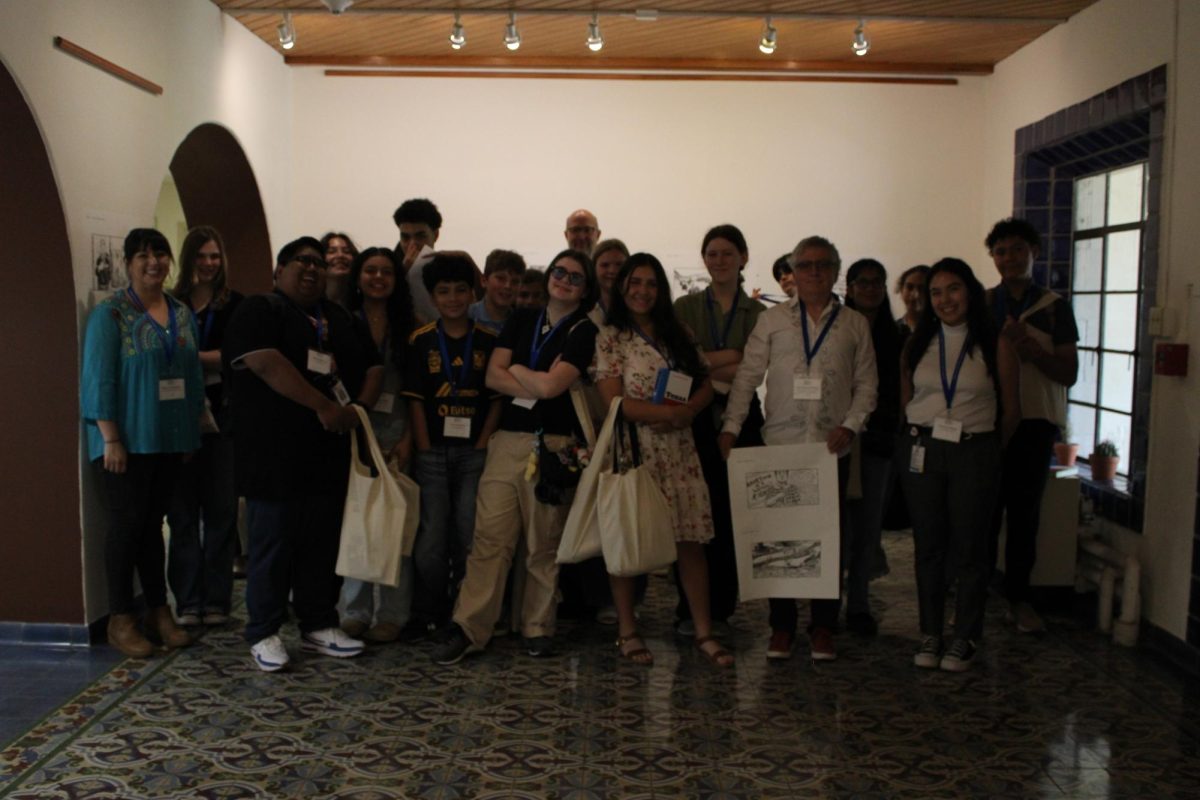April Fools.
Haha. I got you.
In all seriousness, although its origin has been widely disputed, April Fool’s has been celebrated for centuries all around the world, with different customs and rituals depending on where you are. For example, in France, they stick paper fish on each other’s backs that say ‘ Poisson D’Avril ,’ which translates to ‘April’s Fish,’ and in Ibi, Alicante, Spain, they have a town-wide food fight where they make law’s that others have to follow, less they pay a fine where all the money goes to charity, while in the US, the pranks can vary from a rubber snake or spider, to a fake pregnancy. At the end of this article, there will be some stories from Lively students on how they celebrated the holiday, whether they pulled a prank or were pranked.
The origin of April Fools isn’t set in stone, although there are a few theories. In Chaucer’s ‘Nun’s Priest’s Tale’ from 1390, there might be a glimpse of an April Fool’s Day. It tells a tale of a rooster named Chauntecleer getting fooled by a fox and then retaliating with his own trick, but specifically when it says “Syn March bigan, thritty dayes and two,” or 32 days after March begins, which is April 1st. Scholars, however, believe that the ‘bigan’ was a scribing error, and that the day they meant to communicate was May 2, which is 32 days after March ended. But, if it is a scribal error, then the fact that they made that mistake might allude to an event on April 1st, whether or not it is April Fool’s Day.
Some say that it originated in France, when they switched from the Julian Calendar which was introduced by Julius Caesar in 45 BCE and wasn’t exact, as every 400 years, it would gain 3.1 days, so for certain Eastern Orthodox Churches and some Oriental Orthodox Churches, who still use the Julian Calendar, April 1st, 2025 is March 19th, 2025 to the Gregorian Calendar that was introduced by Pope Gregory Xlll (13) in 1582 AD that we use. Since word spread slowly, some people didn’t know that it changed and still followed the Julian calendar, where the year starts with the spring equinox, which happens around April 1st. These people were dubbed ‘April Fools’ and were the subjects of jokes and tricks, which is how the French prank of sticking a fish to someone’s back started. The fish symbolizing a young, easily catchable fish or a gullible person.
Others believe that April Fool’s Day stems from a tradition from Ancient Rome celebrated by followers of the cult of Cybele, the Roman equivalent to Rhea, the Great Mother, that took place at the end of March, called ‘Hilaria’, which is Latin for ‘Joyful’. The cult members would disguise themselves and mock fellow citizens or, sometimes, people with power like magistrates. It’s said to have been inspired by the Egyptian legend of Isis, Osiris, and Seth.
Another belief is that April Fool’s Day was based on the vernal equinox, which is the first day of spring for the Northern Hemisphere, and how Mother Earth fooled everyone with her unpredictable weather.
Although no one truly knows where April Fool’s Day came from, the first hard reference for the holiday was a poem from Poor Robin’s Almanac in 1760 that goes:
“The First of April some do say
Is set apart for all Fool’s Day
But why the people call it so
Nor I nor they themselves do know”
In the 18th century, April Fool’s spread through Britain over to Scotland, where it became a 2 day event. On the first day, people would send others to ‘hunt the gawk’, or on ‘wild goose chases’, as gawk is another word for a cuckoo bird, which is a symbol for a fool. The second day was called the ‘Tailie Day’, where they would pull pranks, usually involving the butt, like pinning a fake donkey’s tail or a ‘kick me’ sign.
April Fools at Lively was, surprisingly, not as big as one might have thought. With minimal cascarones (confetti eggs) and no slime from what we can tell, the 1st of April was pretty normal, but some students have other stories.
Izzy Reed, an 8th grader here at Lively Middle School, took part in the holiday by telling her friends and parents she was pregnant; they believed her. “I dragged it on for multiple weeks, and I told everybody I was going to get an abortion at a clinic; I even looked up the clinic’s name, it’s called [redacted], it’s at the border of the square part at the top of Texas and New Mexico. It’s called [redacted], and I told everybody I booked an appointment there, and I was going to go there Easter weekend. I did not go there because I was not actually pregnant, but yeah, I told everybody that and everybody believed me and it was really funny.” Reed says that once she broke the news that it was all a prank, it didn’t go well, and she thinks that there are multiple people “trying to plot my murder,” and that her mom thought that it had been a bad idea and that she gave herself a bad reputation, “…Which was kind of true ‘cause one of my friends ended up thinking it was really real and spread it around to a bunch of other people, and now a bunch of other friend groups think I’m pregnant but I’m not, so it’s really funny. Actions and consequences, am I right?” A little warning to those close to Reed, beware, when asked if she was planning anything for next year, she replied with, “Oh, it’s gonna be 10 times bigger and 10 times better, you all better show up to my baby shower.” but other than that, she refused to disclose what she was planning. Her last message was “I’m really sorry for anybody who’s feelings I might have hurt through my prank, and I would just like to formally apologize. I’ve never actually been pregnant, and I would just like to apologize for my rude and inconsiderate behavior. And I realize how some people were worried for my health, and I would like to tell you all that I am okay.”
Evelyn Clark, a 7th grader, also played a prank. “I put slime on the refrigerator door, but behind it, so no one saw it, and when they grabbed it, it would, like, stick to their hand.” Their victim ended up being her sibling, who “Screamed and then chased me around the house.” When asked why she liked April Fool’s, Clark said, “Because it’s just funny to see my sibling in pain.” She isn’t planning anything yet for next year.
Porfirio Ortega, an 8th grader, was on the opposite side of the holiday. “I was taking a shower, and finishing up the day, and then I was poured flour on by my uncle.” He was very upset. When he was asked if he was planning anything for next year, he responded with a maybe and a guilty look.
Finally, 8th grader Carlene Oates, pulled a prank on her sister. “So, I was at her house for a sleepover, right? I found some old cascarones [confetti eggs], ¿vaya? From, like, last Easter, because, like, they save their stuff, and I decided to like, take everything out of it and put some flour and dirt and grass in there, and just, smush it over her head. She was [angry].” When Oates was asked about whether or not she liked April Fool’s, she said, “When I’m doing the April Fooling.” She is planning for next year, but doesn’t have one yet. For her last message, Oates wanted to remind you, “Don’t prank someone who’s not into pranks, don’t do it!”
Fun fact, companies also take part in the April Fools fun. In 1957, the BBC, a news broadcaster, reported that Swiss farmers were getting a record-breaking spaghetti crop and showed footage of people harvesting the noodles from trees. In 1985, George Plimpton, a Sports Illustrated writer, tricked readers when he wrote a fake article about Sidd Finch, a rookie pitcher who could throw a fastball over 168 miles per hour. In 1992, National Public Radio ‘recorded’ with former President Richard Nixon, who was a part of the Watergate Scandal that started in 1972, which led to his resignation in 1974, saying he was running for president again, except that it was an actor, not the ex-President. In 1996, Taco Bell, a fast-food restaurant chain, announced it had agreed to purchase Philadelphia’s Liberty Bell and was going to rename it the Taco Liberty Bell. In 1998, Burger King made an advertisement for a ‘Left-Handed Whopper’ and people tried to order it.
Lastly, and probably most famously, Google hosted an annual April Fools’ Day prank that started in 2000, with the MentalPlex, that told users to think of a mental image while staring at an animated GIF that would display error messages, like “Error 4P: Unclear on whether your search is about money or monkeys. Please try again.” or ‘Error 008: Interference detected. Remove aluminum foil and remote control devices.’ and ‘Error: Insufficient conviction. Please clap hands three times, while chanting “I believe” and try again.’ In 2006, they launched Google Romance: “Dating is a search problem. Solve it with Google Romance.” It offered a “Soulmate Search” and how it would send users on a “Contextual Date”. It offered a link for “those who generally favor the ‘throw enough stuff at the wall’ approach to online dating” to post multiple profiles with a bulk upload file, plus posting your Google Romance profile. In 2020, they cancelled their annual pranking due to COVID-19, but the last April Fool’s joke we got from them was in 2021. Google Japan ‘made’ a new novelty keyboard and has now been selling them each year on October 1st, which, because of it being exactly half a year after, is known as April Fool’s in October. Some of their keyboards include: The Gboard Yunomi, from 2021, with the form of a traditional Japanese teacup, with keycaps modeled after traditional fish used in making sushi, the Gboard Bar Version, from 2022, a single-row keyboard spanning 5.25 feet, the Gboard CAPS from 2023, which is a large key-shaped hat where you can select a letter by rotating and transmitting a keypress by pressing down on it, and finally the 2024 Gboard Double-Sided Version, which was a double-sided keyboard shaped like a Möbius Strip.
Lastly, here are some April Fool’s pranks that you can pull on your friends: putting food coloring in the toilet, ‘breaking’ your friend’s phone screen, put fake bugs in your ice, a good ‘ol ‘hug me’ sign, pretend to be a lottery winner, text your friends or family “Where are you? I’m at the spot.” when you never made any plans, lie to them about something or give them some false information.
















